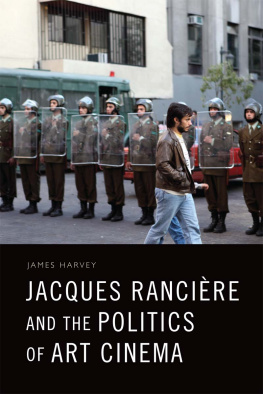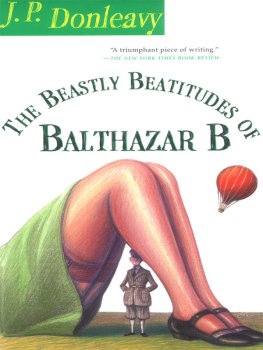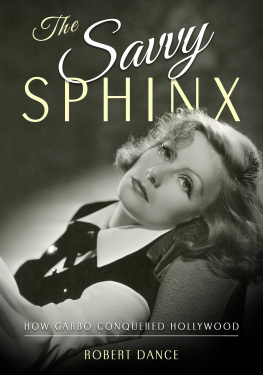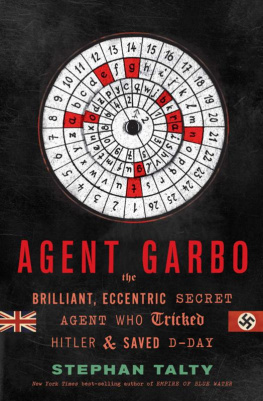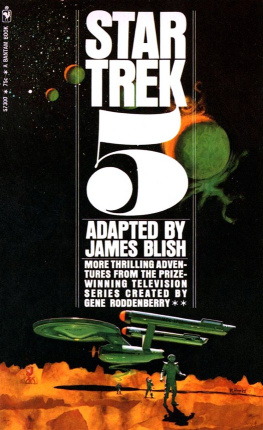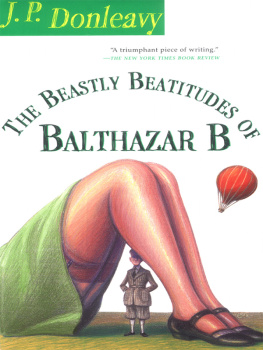James Harvey - Watching Them Be: Star Presence on the Screen from Garbo to Balthazar
Here you can read online James Harvey - Watching Them Be: Star Presence on the Screen from Garbo to Balthazar full text of the book (entire story) in english for free. Download pdf and epub, get meaning, cover and reviews about this ebook. publisher: Farrar, Straus and Giroux, genre: Non-fiction. Description of the work, (preface) as well as reviews are available. Best literature library LitArk.com created for fans of good reading and offers a wide selection of genres:
Romance novel
Science fiction
Adventure
Detective
Science
History
Home and family
Prose
Art
Politics
Computer
Non-fiction
Religion
Business
Children
Humor
Choose a favorite category and find really read worthwhile books. Enjoy immersion in the world of imagination, feel the emotions of the characters or learn something new for yourself, make an fascinating discovery.

- Book:Watching Them Be: Star Presence on the Screen from Garbo to Balthazar
- Author:
- Publisher:Farrar, Straus and Giroux
- Genre:
- Rating:5 / 5
- Favourites:Add to favourites
- Your mark:
- 100
- 1
- 2
- 3
- 4
- 5
Watching Them Be: Star Presence on the Screen from Garbo to Balthazar: summary, description and annotation
We offer to read an annotation, description, summary or preface (depends on what the author of the book "Watching Them Be: Star Presence on the Screen from Garbo to Balthazar" wrote himself). If you haven't found the necessary information about the book — write in the comments, we will try to find it.
James Harvey: author's other books
Who wrote Watching Them Be: Star Presence on the Screen from Garbo to Balthazar? Find out the surname, the name of the author of the book and a list of all author's works by series.
Watching Them Be: Star Presence on the Screen from Garbo to Balthazar — read online for free the complete book (whole text) full work
Below is the text of the book, divided by pages. System saving the place of the last page read, allows you to conveniently read the book "Watching Them Be: Star Presence on the Screen from Garbo to Balthazar" online for free, without having to search again every time where you left off. Put a bookmark, and you can go to the page where you finished reading at any time.
Font size:
Interval:
Bookmark:
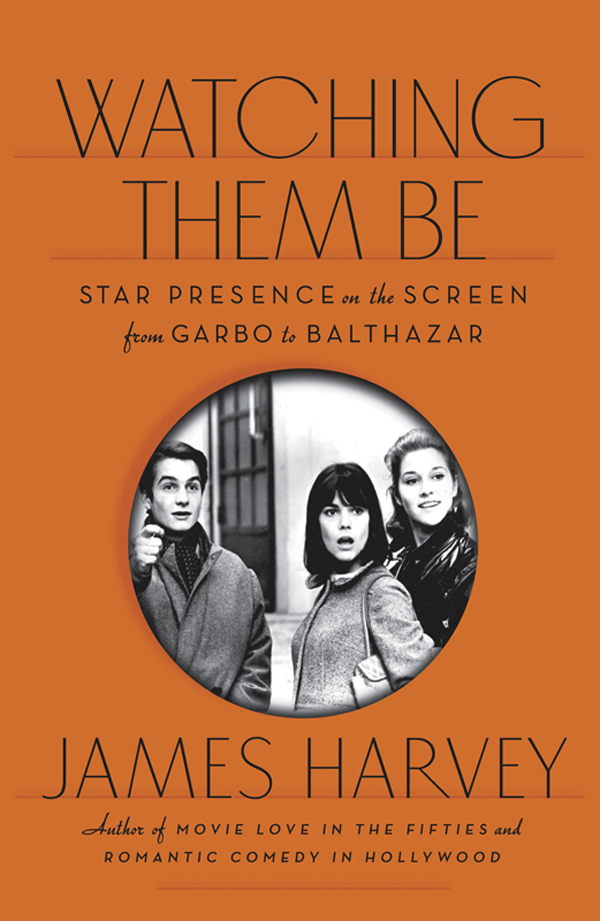
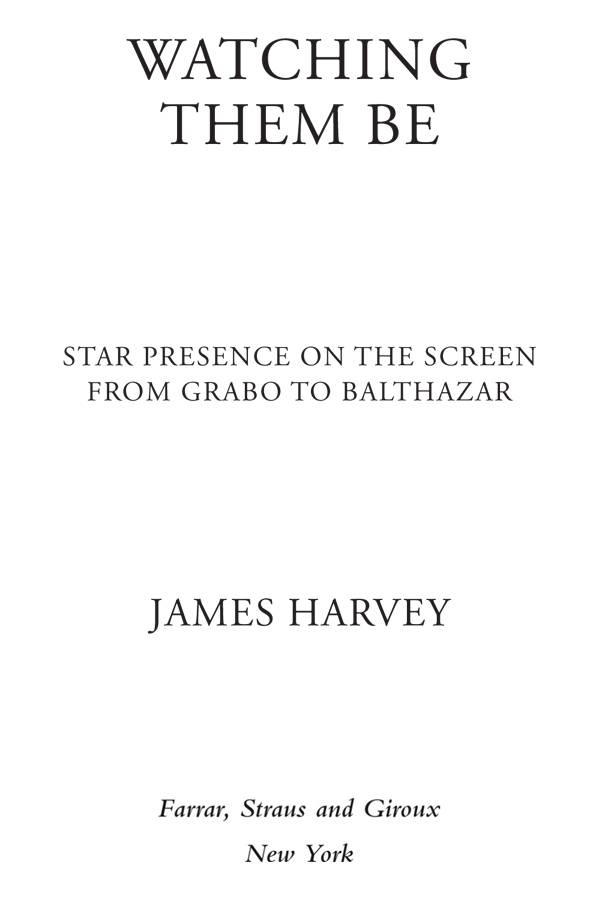
The author and publisher have provided this e-book to you for your personal use only. You may not make this e-book publicly available in any way. Copyright infringement is against the law. If you believe the copy of this e-book you are reading infringes on the authors copyright, please notify the publisher at: us.macmillanusa.com/piracy.
As before, as always
for Betty Ann
ILLUSTRATIONS
CONTENTS
PREFACE
ONE DOES NOT go to see them act, wrote James Baldwin about the great iconic movie stars Wayne and Davis and Bogart, one goes to watch them be (italics his). Of course. It seems obvious, you think, once hes said it (in The Devil Finds Work , 1976). Thats what we do at the movieswhat we still do. We watch our fellow human beings, but in a special way. The theater actor, however magnetic, however good your seat is, is always at an impersonal distance. At the movies, that distance is banishedand for all the seats. The stage star may be real, but the one on the movie screen, who is not , feels even realer. Where else besides the movies do you get to see other persons so intimately, so pressingly, so largely even? Where else such intense and close, such sustained and searching looks as you have of these strangers on the screen, whoever they really are? In life you try not to stare, but at the movies thats exactly what you get to do, for two hours or moresafely, raptly, even blissfully. The actor in the theater disappears into a role, at least ideally; the movie star, never. Just the reverseeven if he is an actor, even if hes a great one. Theres always that close-up. The screen performer is essentially not an actor at all, says Stanley Cavell; instead, he is the subject of study, and a study not his own.
PART ONE
ICONS
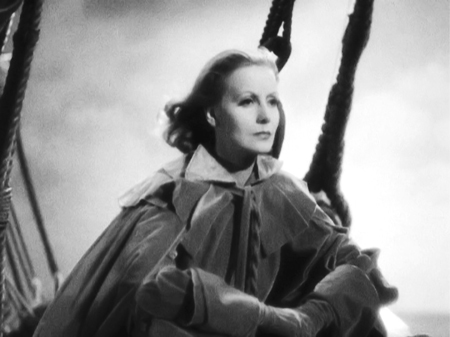
Greta Garbo in Queen Christina
Garbo
I.
SO WHAT WAS it about Garbo? In her time she evoked more widely felt and declared awe than any movie star ever has, before her or since. She was never the most popular star, at least in the United States (she was too austere for that). She was nevertheless for most people then the definitive one, even for those who had never seen her movies. Her counterparts at the time were not Gish or Gable or Fairbanks but Charlie Chaplin and Mickey Mouseicons beyond their movies. But where the latter two offered fantasy versions of the commonplace, Garboas she came to be seenoffered something that approached sublimity. Not an easy thing to pull off, at least persuasively, not only in a realist medium but in a Hollywood whose truest and most reliable bent was for a cinema of common sense, for the reductive and the comic. She could do the latter, as it later turned out, but only at the end ( Ninotchka , her next-to-last movie).
She was famously, even pathologically, shy. Where other screen stars would try to make up for the distance between themselves and their fansgiving interviews, making public appearances, telling their carefully prepared storiesGarbo only compounded the remove by refusing all publicity. Her celebrity became a kind of public privacy as a result. By the time of her talkies, I want to be alone was the line that everyone knew her bylike Mae Wests Come up and see me sometime, or Charles Boyers Come with me to the Casbahthough in fact she had said it for the public record only twice, once to intrusive shipboard reporters and then once as a character in a movie (Boyer never said that Casbah line at all).
Her fame was inseparable from her riddle. A widely circulated photocollage from the mid-1930s showed her face imposed on the Egyptian Sphinx. She had become the most famous woman in the worldand her enigma seemed to haunt it. And no wonder. You take your secret with you when you die, its said: Garbo seemed to have taken herssafely enough as it turned outinto the movies.
Camille (1937) was her greatest film and performance, but it was an earlier and lesser movie in which she had her most celebrated and most epiphanic single close-up: in the final shot of 1933s Queen Christina . Where the eponymous heroine, having renounced her Swedish throne and then lost the lover she had renounced it for (killed in a duel over her), now gives the orders to the crew of the great ship to set sail nonetheless for the exile in Spain that she had meant to share with him. Now rising from her grief over his body, laid out on the deck by the sailors, she slowly crosses the ships length, as the men of the crew shout and climb the riggings and the enormous sails rise billowing around her. Until she reaches the prowand the famous close-up.
It begins as a medium close shot (see preceding illustration), which frames her as she moves into place and stands, resting her elbows on the railing above the figurehead, leaning on her forearms and looking out to sea, her uncovered hair lifting gently in the wind (a mistake: even in old movies you dont normally sail directly into the windbut never mind). But then the camera tracks slowly in on her, with movie music swelling, to her face in extremest close-up, to her unblinking gaze, which the film holds until the final fadeout.
It was partly the duration of this shot, unusual for the time, even for a Garbo movie, that made it famous. A testament to the power of the Garbo image. But it was something more than that, too
I first saw her on the screen in 1955, twelve years after she had retired from it altogether, in Camille , which MGM had rereleased that year with all the fanfare of a first-run movie and to wide acclaim. I remember the crowded theater in Chicagos Loop, a mostly young audience, as new to her probably as I was at the time, and a feeling in the place like revelation: So this is what a movie star is or was, at any rate.
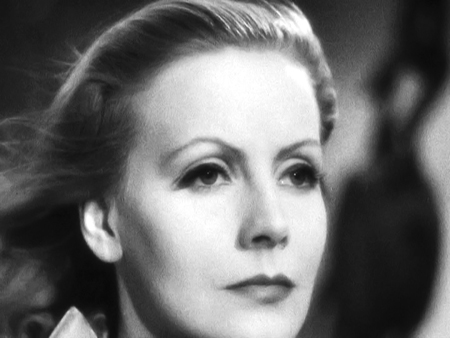
The close-up before the final fadeout ( Queen Christina )
You first see her in that movie inside a carriage as she lowers her face into a bouquet of camellias, smiling with her eyes at the motherly little flower seller who has just handed it to her with a blessing: For the lady of the camellias. What strikes you at first is not so much her beautywhich was then legendaryas her brimmingness, her feeling of eager life. It is that, as the movie goes on, which makes the beauty seem ravishing, irresistible. Its a classically perfect face, without a single bad angle, according to those who photographed it. But its lack of sensual emphasesthe lips are thin, the nose prominent, as far from being pretty as a beautiful face could becould also make it look plain. Not everyone, even at the time, saw its beauty. Graham Greene, a movie reviewer in the 1930s, imagined his descendants puzzling over it, looking for something more obvious. For Roland Barthes, writing in the fifties (The Face of Garbo), its perfection evoked a Platonic heaven, the Divine Garbo, as she was called, seeming to him more of an ideal of beauty than a sensuous specific of it. That account of it at least might help to explain how she could be so moving in these first Camille close shotsdescending to us, as it were, just as she descends, inclining her head, to those flowers.
It was the year after this that I saw Queen Christina , in a Harvard Square revival house. But I had already heard or read about the final shot. And when I did see it, I had no trouble understanding why it was famous. It was still overwhelming. Partly because it was so surprisingby the usual movie standards. Here was the tragic heroine getting her final big close-upand what was she showing on the screen? None of the things we could have expected from the film wed just seensome stage of grief or prayerfulness, of desolation or heroic restitution. But noinstead something like impassivity, refusing the usual emotions, inviting us to do the same. But offering what instead? Blankness?as her director Rouben Mamoulian later suggested in interviews. He had instructed her to empty her mind.
Font size:
Interval:
Bookmark:
Similar books «Watching Them Be: Star Presence on the Screen from Garbo to Balthazar»
Look at similar books to Watching Them Be: Star Presence on the Screen from Garbo to Balthazar. We have selected literature similar in name and meaning in the hope of providing readers with more options to find new, interesting, not yet read works.
Discussion, reviews of the book Watching Them Be: Star Presence on the Screen from Garbo to Balthazar and just readers' own opinions. Leave your comments, write what you think about the work, its meaning or the main characters. Specify what exactly you liked and what you didn't like, and why you think so.

